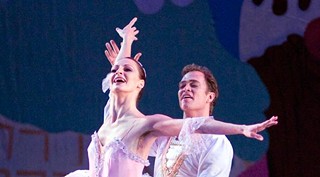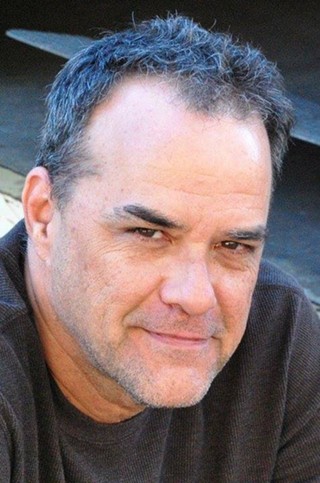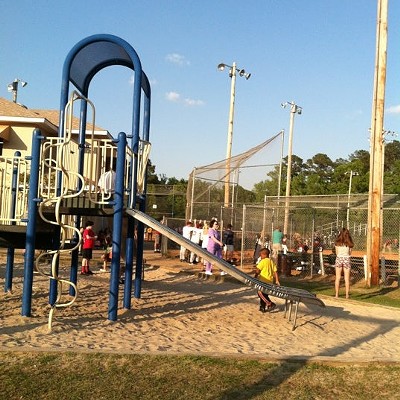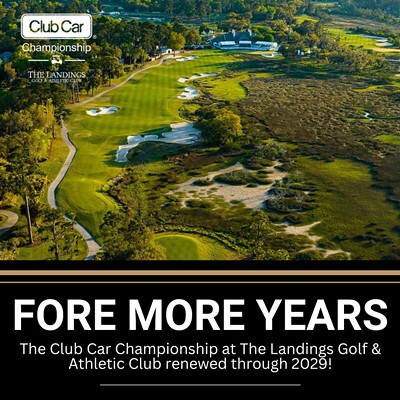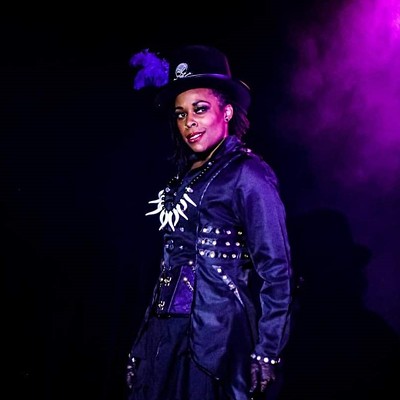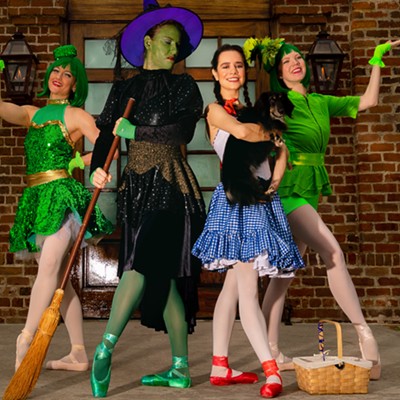Everybody dance now!
In The Nutcracker, a little girl named Clara has a series of increasingly strange (some might say pseudo–psychedelic) dreams in which toys come to life and dance, mice come to life and dance, snowflakes dance, candy dances, coffee (!) dances.
There’s combat, romance, international intrigue, bickering and family squabbles, all induced by sugar intake. There’s even a “Grandfather Dance.” The Nutcracker, you might say, has got it all.
That’s a perhaps–too–simplistic way of describing The Nutcracker, a ballet that premiered in Russia more than 120 years ago, but didn’t become a Christmas perennial until midway through the last century. Today, The Nutcracker is as much a part of the American Christmas tradition as Charlie Brown, the Walmart rollback and Rudolph, the Red–Nosed Reindeer.
On Saturday, Nov. 26, the professional Columbia City Ballet returns to Savannah with its annual gift of The Nutcracker, in the Johnny Mercer Theatre. At the Lucas Theatre, Savannah Danse Theatre’s production is presented twice on that same day.
Both shows feature adult dancers and an enormous supporting cast of young dance students. Neither is using a real orchestra this year – although, it could be argued, when the evocative music by Pytor Ilyich Tchaikovsky fills the room, whether it’s live or Memorex, the dreamy Christmas atmosphere is created and sustained.
They’re all here – Clara, Drosselmeyer, Fritz, the Nutcracker, the Cavalier, the Gum Drops and the disagreeable Mouse King. The Danse Theatre sets the proceedings in Savannah, using local place and character names.
The most unforgettable character in The Nutcracker, throughout history, has always been the Sugar Plum Fairy. She has no narrative, no real place in the story, but her impossibly beautiful dance – set to Tchaikovsky’s most enchanting theme – stays with you long after Clara and the rest have become a dim memory.
• She is one of the most famous characters in ballet, and yet she only turns up in the final 10 minutes of The Nutcracker (after a brief cameo at the start of Act Two). But the Sugar Plum Fairy is “the doyenne of the kingdom of sweets,” the purest realization of all that Clara finds wonderful about Christmastime. Her pas de deux with a dreamy prince is the show’s triumphant climax.
• It’s not as showy as Swan Lake, Giselle or Sleeping Beauty, but the Sugar Plum Fairy is considered one of the most challenging roles in classical ballet – she’s light and fast and delicate, and every little ballet class–taking little girl’s dream part. Most modern adaptations take their cue from the classic 1954 choreography by George Balanchine. .
• The delicate–sounding musical instrument that gives the Sugar Plum Fairy such a memorable, ethereal presence during her appearance is the celesta, a relative of the glockenspiel. It looks like a small upright piano, and is in fact a three–octave keyboard. Tchaikovsky, who’d used the instrument in his symphonic poem The Voyevoda (1891), chose it for the Sugar Plum Fairy dance because it made a “heavenly” sound (celeste means heavenly in French). One of the best–known uses of the celesta in 20th century pop music was in Buddy Holly’s record “Everyday.” It is not known whether Holly ever danced the role of the Sugar Plum Fairy.
• “Visions of sugar plums danced in their heads,” Clement C. Moore wrote in his famous (and usually misquoted) 1823 poem about gold old Santa rifling through stockings hung by the chimney with care. A sugar plum is a traditional European Christmas treat: Dried fruit (not necessarily a plum – apricots, cherries, dates or figs were often used) was chopped fine, blended with honey, chopped nuts, seeds or anything else that tasted good, rolled into balls and coated with sugar.
• A little history: In 1816 German writer, composer and artist E.T.A Hoffman wrote a dark, adult fairy tale about Christmas called The Nutcracker and the Mouse King. This was adapted by Frenchman Alexandre Dumas (The Three Musketeers) in 1844 into a more family–friendly story, and it was the Dumas work that attracted the attention of Marius Petipa, dancer, choreographer and chief master of the Russian Imperial Ballet. Petipa’s assistant Lev Ivanov created the initial choreography, and Tchaikovsky was commissioned to create the score. The Nutcracker debuted Dec. 18, 1892 in St. Petersburg, Russia.
• Dancing the role for the Columbia City Ballet this year is the company’s prima ballerina Regina Willoughby. The Texas native came to CCB in 1997 and became a soloist four years later. Director William Sterret has since created roles specifically for her in his original productions, including Cleopatra, Off the Wall and Dracula’s Revenge. She is also a dance teacher and a realtor.
• Russian native Joulia Moisseva is dancing the Sugar Plum Fairy for the Savannah Danse Theatre’s production (she teaches there periodically). Moisseva, who like Willoughby is a resident of Columbia, S.C., danced with the Moscow Festival Ballet, the Kremlin Ballet Company and the Modern Theater (in the Czech Republic). She’s been on international ballet tours that took her to China, Taiwan, Mexico, Austria, Norway, France Italy and the USA, where she arrived in 1996 and worked on the dance faculty at USC’s Columbia campus.
Savannah Danse Theatre
The Nutcracker in Savannah
Where: Lucas Theatre, 32 Abercorn St.
When: At 2 and 7:30 p.m. Saturday, Nov. 26
Tickets: $12 matinee (with a “character meet and greet” after the show), $15–$35 for the evening performance
Phone: (912) 525–5050
Online: scadboxoffice.com
Columbia City Ballet
The Nutcracker
Where: Johnny Mercer Theatre, Savannah Civic Center, 301 W. Oglethorpe Ave.
When: At 5:30 p.m. Saturday, Nov. 26
Tickets: $20–$42 at etix.com

